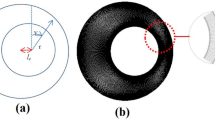Abstract
In this study, an artificial neural network (ANNs) for the prediction of unsteady heat transfer in a rectangular duct was studied. The ANNs has been applied for the unsteady heat transfer in a rectangular duct. An experimental study has been carried out to investigate the axial variation of inlet temperature and the impact of inlet frequency on decay indices in the thermal entrance region of a parallel plate channel. The investigation was conducted with laminar forced flows for Reynolds numbers ranging from 1,120 to 2,200 while the inlet heat input frequency varied from 0.02 to 0.24 Hz. The results revealed that the ANNs can be used for modeling unsteady heat transfer in the duct. The accuracy between experimental and ANNs approach results was achieved with a mean absolute relative error less than 39%.









Similar content being viewed by others
Abbreviations
- a :
-
the width of the rectangular channel, m
- b :
-
half height of the rectangular channel, m
- d :
-
diameter of the orifice plate, m
- D e :
-
equivalent diameter of rectangular test section or hydraulic diameter, m
- D p :
-
diameter of PVC pipe, m
- f :
-
logistic sigmoid activation function
- h :
-
hidden layer
- O :
-
output
- OL:
-
output layer
- m :
-
mass flow rate, kg/s
- p :
-
design parameter (consequent parameter)
- Pr:
-
Prandtl number
- q :
-
design parameter (consequent parameter)
- r :
-
design parameter (consequent parameter)
- t :
-
time
- T :
-
temperature,°C
- V :
-
output voltage of thermocouple, mV
- w :
-
wiring strength of a rule
- W :
-
weights
- x :
-
axial distance, m
- X :
-
input
- Y :
-
target activation of the output layer
- Z :
-
dimensionless distance, Z=x/D e
- α:
-
learning rate
- β:
-
inlet frequency, Hz
- δ:
-
error for output neuron
- φ:
-
orifice plate diameter ratio, d/D p
- ρ:
-
fluid density, kg/m3
- μ:
-
dynamic viscosity, Pa s
- ΔP :
-
pressure drop across the orifice plate, Pa
- ΔT i :
-
temperature amplitude at the center of the inlet,°C
- θ:
-
threshold between the input and hidden layers
- η:
-
momentum factor
- I:
-
input
- max:
-
maximum
- min:
-
minimum
- o:
-
output
- p:
-
value related to the redevelopment section
- t:
-
value related to the test section
- amp:
-
amplitude
References
Kakaç S, Li W, Cotta RM (1990) Unsteady laminar forced convection with periodic variation of inlet temperature. Trans ASME J Heat Transfer 112:913–920
Li W, Kakaç S (1991) Unsteady thermal entrance heat transfer in laminar flow with a periodic variation of inlet temperature.Int J Heat Mass Transfer 34:2581–2592
Sozbir N (1995) Experimental investigation of unsteady forced convection in a rectangular channel with or without arrays of block-like electronic component, Report, University of Miami, Coral Gables, FL, USA
Sozbir N, Brown DM, Santos CAC, Kakac S, Guven HR (1995) Experimental Investigation of unsteady forced convection in a channel with and without arrays of rectangular protruding surfaces. J Therm Sci Technol 17(4): TIBTD Printed in Turkey, ISSN 1300–3615
Ekmekci I et al (2001) Investigation of forced convection in a duct with artificial neural network. In: 3rd International symposium on intelligent manufacturing systems, Sakarya, Turkey, pp 30–31
Hasiloglu A et al (2004) Adaptive neuro-fuzzy modeling of transient heat transfer in circular duct airflow. Int J Therm Sci 43:1075–1090
Kalogirolu SA (2000) Applications of artificial neural networks for energy systems. Apply Energy 67:17–35
Xu K et al (1998) Integration of neural networks and expert systems for microscopic wear particle analysis. Knowl-Based Syst 11:213–227
ASME Standards (1984) Measurement of fluid flow in pipe using orifice, nozzle and venture, MCF-3M-1984
Author information
Authors and Affiliations
Corresponding author
Rights and permissions
About this article
Cite this article
Sözbir, N., Ekmekçi, İ. Experimental study and artificial neural network modeling of unsteady laminar forced convection in a rectangular duct . Heat Mass Transfer 43, 749–758 (2007). https://doi.org/10.1007/s00231-006-0156-0
Received:
Accepted:
Published:
Issue Date:
DOI: https://doi.org/10.1007/s00231-006-0156-0



